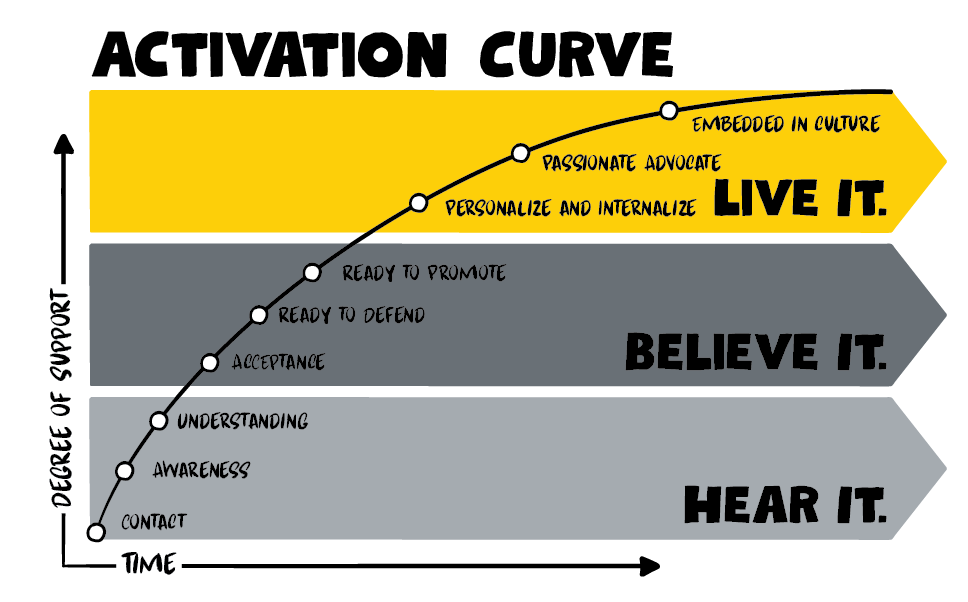If you want to execute your organization’s strategy responsibly, use these eight tactics to successfully activate your strategy and accelerate your organization’s results.
As mentioned in our recent webinar, $38 billion dollars—that’s billion with a “B”—are spent annually purely on strategy consulting with management consulting firms1. The world’s largest companies spend some multiple of that internally when you count the hours committed by key personnel in the annual strategic planning process. And yet it’s reported that 80% of corporate strategies fail. That’s right, 80% of that investment is wasted2, churned without results to show.
Most internal strategists and their consulting advisors do a great job understanding where their company should go and devising potentially effective strategies to get there. Where they fail is follow-through—investing in what it takes to actually activate their strategy. They’ve shared the strategy with the company in the newsletter, by email, and in the all-hands meeting, but they’ve failed to understand that a message sent does not equal a message received.
So, what’s the formula for successfully activating your strategy, and even accelerating your organization’s results? Along with these three powerful principles for bringing your strategy to life, consider building these eight tactics into your strategy activation plan:
1. Co-create – people support what they create
From the start, include key influencers and executives in the strategy creation process, even if only for periodic reviews and feedback. It’s even better if you can include a broader group during the brainstorming and ideation phases so that new ideas can bubble to the top. When people see their own fingerprints in the plan, they are much more likely to both support and promote it to others.
Co-creation practices help to crowd-source knowledge, accelerate plan adoption, and build ambassadors throughout the process.
2. Invest in activation – a message sent is not a message received
The biggest failure is assuming employees will just snap to a new plan once they hear it. That’s not how we’re wired. Humans are inherently skeptical and need to not only hear new information multiple times, but be convinced that it’s correct, and in their interest, in order to start changing behavior.
We call this moving people up the “Activation Curve”, which promotes an activation plan that creates multiple touch points so that employees hear it, believe it, and eventually live it.

3. Empathize – why does each audience want to change?
When designing communications about the strategy, it’s critical that you empathize with your employees and put yourself in their shoes. For instance, Bob’s been doing his job the same way for years, what’s it going to take to get him to do something different on Monday morning?
The key questions that you need to answer for Bob are: What’s in it for me? Why is this better than the way we did it before? How will you remove the risk for me and support me along the way if I start doing things differently?
4. Visualize – make it so clear that you can point at it somewhere
A strategy isn’t clear until you can draw it on a napkin, or, better yet, up on a wall. Challenge your team to visualize your strategy and then put it on a wall where everyone can see it, engage with it, discuss it, and be imprinted by it.
Visualizing your strategy creates a common map for everyone to follow, gives your team a script to describe it to others, and helps people understand where they fit into the plan and how they can make an impact.
5. Systemize – it’s not an island, it’s a chain
A strategy will fail if it’s not linked to your other core processes in a meaningful way. It’s not an island; it’s a critical link in the chain of how your business operates.
As a check, ensure that your strategy clearly links to and complements your vision and mission for the company. Be sure your budget ties directly to the initiatives and support required to deliver the strategy. Be sure your performance management system holds executives accountable for the initiatives, goals, and impact outlined in the strategy. In short, if you can’t draw a straight line between all of these operational systems, go back to the drawing board before you deploy it.
6. Engage employees – make it fun
Employees are overwhelmed by information. If you want to engage them, you need to try new and different techniques, and I dare say, make it fun. People learn by understanding information, rehearsing activities that apply that information, getting feedback and repeating.
Broadcasting a 100-page PowerPoint Deck isn’t going to activate your strategy—that’s one-way communication. Make it omnidirectional by engaging employees in workshops, simulations, role-playing, even game-playing. Strategy games in small teams are a great way for employees to rehearse and see the impact of a good strategy in a safe, risk-free environment. They empower them to go forward confidently.
7. Embed it in your organizational DNA – everywhere they are, you are
For change to take hold, you must embrace the mechanisms that already exist in your culture in order to change it. Where do people gather? How do they communicate, both officially and unofficially? How does your company show up in their lives?
Find those flagpoles, sign-posts and meeting places that exist in your company and hang your key messages – even in bite-sized chunks, where they are likely to become part of the day-to-day. Everything from break-room signage to lunch-room table tents to company swag can reinforce key messages and help embed them in the DNA.
8. Make it agile – no plan survives the first contact
We always chart a straight path to our destination, but we will inevitably be blown off course from time to time by internal, external, and unforeseen circumstances. Anticipate this and build it into the activation program, so your organization can learn and adapt faster.
Best practices here include the creation of feedback loops for employees to share their experiences and solutions, chunking up initiatives into short sprints so progress can be made consistently and iteratively, and building “after action reviews” into each stage of an initiative so the team can share, learn, and adapt in real-time. In addition to making the organization more proactive and adaptive, each step forward removes skepticism and increases momentum among the team.
I’d like to challenge strategy leaders to build strategy activation into their strategy investment from the start. Investing 10-15% as much to activate a strategy as it costs to develop it is easy math when you consider the cost of an otherwise 90% risk of failure. A strategy will only succeed if your entire team sees the same destination, believes in the plan, and starts rowing the boat in the same direction, together.
If you have thoughts to share or questions about this approach, we would love to hear from you.
Are you responsible for executing strategy?
Want to Learn More?
In addition to the material covered in this post, our latest webinar elaborates on three powerful principles to bring your strategy to life and overcome strategy failure.
If you have questions or comments on this post, please reach out to us. We’re all about helping you get the results you want.
For a deeper dive into strategy activation, we also recommend the following posts:
- What is Strategy? (a strategy primer)
- Two Fun Ways to Get Your Strategy Off the Ground (how to make strategy fun—and effective)
Citations:
1Consultancy.org, The Global Consulting Market
2Robert Kaplan & David Norton, The Balanced Scorecard
